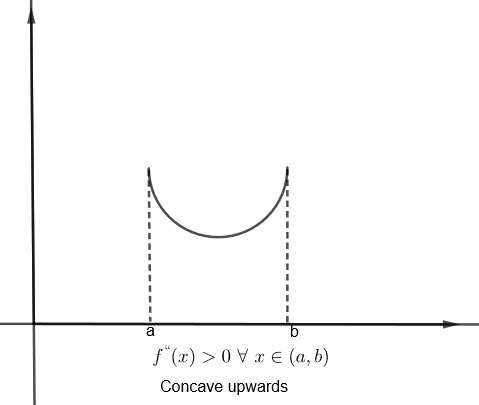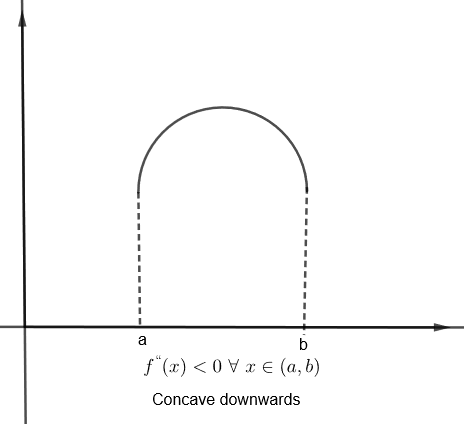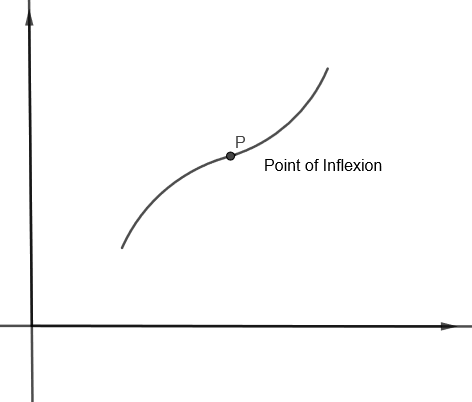
Find the intervals of concavity and the points of inflexion of the function
\[f\left( x \right)={{\left( x-1 \right)}^{\dfrac{1}{3}}}\]
Answer
605.7k+ views
Hint: Double differentiate the given f(x) and find whether it is positive or negative. When f''(x) > 0, then the graph of f (x) is concave upwards and when f''(x )< 0, then the graph of f (x) is concave downwards. Also we will get the inflexion point at x where f'' (x) = 0 or does not exist.
Complete step-by-step answer:
Here we have to find the intervals of concavity and points of inflexion of function
\[f\left( x \right)={{\left( x-1 \right)}^{\dfrac{1}{3}}}\]
We know that if double derivative of function which is \[{{f}^{''}}\left( x \right)>0\text{ }\forall \text{ }x\in \left( a,b \right)\], then the graph of f (x) is concave upwards in (a, b).
Similarly, if \[{{f}^{''}}\left( x \right)<0\text{ }\forall \text{ }x\in \left( a,b \right)\], then the graph of f (x) is concave downwards in (a, b).


The point at which concavity of graph changes, i.e. \[\dfrac{{{d}^{2}}x}{d{{y}^{2}}}=0\] or does not exist is the point of inflexion.
The sign of \[\dfrac{{{d}^{2}}x}{d{{y}^{2}}}\] changes about the point of inflexion.

Now, we can take
\[f\left( x \right)={{\left( x-1 \right)}^{\dfrac{1}{3}}}\]
We know that,
\[\dfrac{d}{dx}\left( {{x}^{n}} \right)=n{{x}^{n-1}}\]
Now, we will differentiate f (x). We get,
\[{{f}^{'}}\left( x \right)=\dfrac{1}{3}{{\left( x-1 \right)}^{\dfrac{1}{3}-1}}\]
\[{{f}^{'}}\left( x \right)=\dfrac{1}{3}{{\left( x-1 \right)}^{\dfrac{-2}{3}}}\]
Now, again we will differentiate the above equation. We get,
\[{{f}^{''}}\left( x \right)=\dfrac{1}{3}\left( \dfrac{-2}{3} \right){{\left( x-1 \right)}^{\dfrac{-2}{3}-1}}\]
\[{{f}^{''}}\left( x \right)=\dfrac{-2}{9}{{\left( x-1 \right)}^{\dfrac{-5}{3}}}\]
Or, \[{{f}^{''}}\left( x \right)=\dfrac{-2}{9{{\left( x-1 \right)}^{\dfrac{5}{3}}}}\]
We know that the point of inflexion is a point where \[{{f}^{''}}\left( x \right)=0\] or does not exist. It changes its sign.
As we can see that \[{{f}^{''}}\left( x \right)\] cannot be zero but \[{{f}^{''}}\left( x \right)\] will not exist at x = 1 as (x – 1) which is in the denominator will become zero at x = 1.
Now, for x > 1, (x – 1) would be greater than zero. So,
\[{{\left( x-1 \right)}^{\dfrac{5}{3}}}>0\]
Therefore,
\[{{f}^{''}}\left( x \right)=\dfrac{-2}{9{{\left( x-1 \right)}^{\dfrac{5}{3}}}}<0\]
As for any value of x, say x = 2 in this case, we would get the value of \[{{f}^{''}}\left( x \right)\text{ as }\dfrac{-2}{9}\].
Now, for x < 1, (x – 1) would be less than zero. So,
\[{{\left( x-1 \right)}^{\dfrac{5}{3}}}<0\]
Therefore,
\[{{f}^{''}}\left( x \right)=\dfrac{-2}{9{{\left( x-1 \right)}^{\dfrac{5}{3}}}}>0\]
As for any value of x, say x = 0 in this case, we would get the value of \[{{f}^{''}}\left( x \right)\text{ as }\dfrac{2}{9}\].
Therefore, as f”(x) does not exist at x = 1, and f”(x) is positive for x < 1 and negative for x > 1, that is f (x) changes its sign about the point x = 1. Therefore, x = 1 is inflexion point.
As we have proved that f”(x) > 0 for x < 1
Therefore, f(x) is concave upwards for \[\left( -\infty ,1 \right)\]
As we have proved that f”(x) < 0 for x > 1
Therefore, f(x) is concave downwards for \[\left( 1,\infty \right)\]
Note: Students should always check if the function is changing its sign at an inflexion point and not only rely upon \[\dfrac{{{d}^{2}}y}{d{{x}^{2}}}=0\] or does not exist for finding the inflexion point.
Complete step-by-step answer:
Here we have to find the intervals of concavity and points of inflexion of function
\[f\left( x \right)={{\left( x-1 \right)}^{\dfrac{1}{3}}}\]
We know that if double derivative of function which is \[{{f}^{''}}\left( x \right)>0\text{ }\forall \text{ }x\in \left( a,b \right)\], then the graph of f (x) is concave upwards in (a, b).
Similarly, if \[{{f}^{''}}\left( x \right)<0\text{ }\forall \text{ }x\in \left( a,b \right)\], then the graph of f (x) is concave downwards in (a, b).


The point at which concavity of graph changes, i.e. \[\dfrac{{{d}^{2}}x}{d{{y}^{2}}}=0\] or does not exist is the point of inflexion.
The sign of \[\dfrac{{{d}^{2}}x}{d{{y}^{2}}}\] changes about the point of inflexion.

Now, we can take
\[f\left( x \right)={{\left( x-1 \right)}^{\dfrac{1}{3}}}\]
We know that,
\[\dfrac{d}{dx}\left( {{x}^{n}} \right)=n{{x}^{n-1}}\]
Now, we will differentiate f (x). We get,
\[{{f}^{'}}\left( x \right)=\dfrac{1}{3}{{\left( x-1 \right)}^{\dfrac{1}{3}-1}}\]
\[{{f}^{'}}\left( x \right)=\dfrac{1}{3}{{\left( x-1 \right)}^{\dfrac{-2}{3}}}\]
Now, again we will differentiate the above equation. We get,
\[{{f}^{''}}\left( x \right)=\dfrac{1}{3}\left( \dfrac{-2}{3} \right){{\left( x-1 \right)}^{\dfrac{-2}{3}-1}}\]
\[{{f}^{''}}\left( x \right)=\dfrac{-2}{9}{{\left( x-1 \right)}^{\dfrac{-5}{3}}}\]
Or, \[{{f}^{''}}\left( x \right)=\dfrac{-2}{9{{\left( x-1 \right)}^{\dfrac{5}{3}}}}\]
We know that the point of inflexion is a point where \[{{f}^{''}}\left( x \right)=0\] or does not exist. It changes its sign.
As we can see that \[{{f}^{''}}\left( x \right)\] cannot be zero but \[{{f}^{''}}\left( x \right)\] will not exist at x = 1 as (x – 1) which is in the denominator will become zero at x = 1.
Now, for x > 1, (x – 1) would be greater than zero. So,
\[{{\left( x-1 \right)}^{\dfrac{5}{3}}}>0\]
Therefore,
\[{{f}^{''}}\left( x \right)=\dfrac{-2}{9{{\left( x-1 \right)}^{\dfrac{5}{3}}}}<0\]
As for any value of x, say x = 2 in this case, we would get the value of \[{{f}^{''}}\left( x \right)\text{ as }\dfrac{-2}{9}\].
Now, for x < 1, (x – 1) would be less than zero. So,
\[{{\left( x-1 \right)}^{\dfrac{5}{3}}}<0\]
Therefore,
\[{{f}^{''}}\left( x \right)=\dfrac{-2}{9{{\left( x-1 \right)}^{\dfrac{5}{3}}}}>0\]
As for any value of x, say x = 0 in this case, we would get the value of \[{{f}^{''}}\left( x \right)\text{ as }\dfrac{2}{9}\].
Therefore, as f”(x) does not exist at x = 1, and f”(x) is positive for x < 1 and negative for x > 1, that is f (x) changes its sign about the point x = 1. Therefore, x = 1 is inflexion point.
As we have proved that f”(x) > 0 for x < 1
Therefore, f(x) is concave upwards for \[\left( -\infty ,1 \right)\]
As we have proved that f”(x) < 0 for x > 1
Therefore, f(x) is concave downwards for \[\left( 1,\infty \right)\]
Note: Students should always check if the function is changing its sign at an inflexion point and not only rely upon \[\dfrac{{{d}^{2}}y}{d{{x}^{2}}}=0\] or does not exist for finding the inflexion point.
Recently Updated Pages
Master Class 12 Business Studies: Engaging Questions & Answers for Success

Master Class 12 Economics: Engaging Questions & Answers for Success

Master Class 12 English: Engaging Questions & Answers for Success

Master Class 12 Maths: Engaging Questions & Answers for Success

Master Class 12 Social Science: Engaging Questions & Answers for Success

Master Class 12 Chemistry: Engaging Questions & Answers for Success

Trending doubts
Who was the first woman to receive Bharat Ratna?

Write a letter to the principal requesting him to grant class 10 english CBSE

Why is there a time difference of about 5 hours between class 10 social science CBSE

What is the median of the first 10 natural numbers class 10 maths CBSE

The Equation xxx + 2 is Satisfied when x is Equal to Class 10 Maths

Discuss the main reasons for poverty in India




